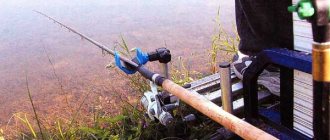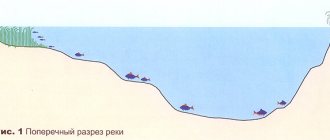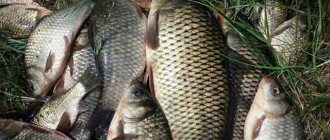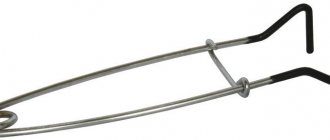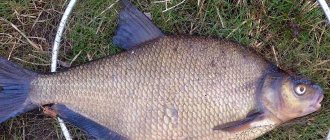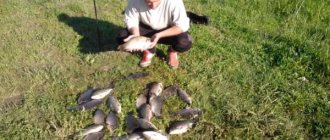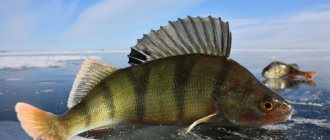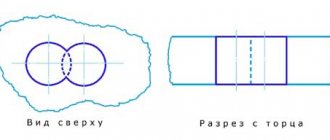Why use scents when fishing and how to use them
Smells can attract fish, because they have a highly developed sense of smell at the molecular level. For this purpose, fishing enthusiasts use fish flavorings. The compositions are divided into options for bait and for biting. The former are designed to attract fish to the fishing site; dips or bite flavors are necessary for successful fishing.
The devices are used in the following way:
- aromatic compounds are added directly to the finished bait;
- The scent is applied to maggots and worms every hour;
- the compositions are stored in the refrigerator;
- When adding flavor, proportions must be observed.
If you want to catch a certain type of fish, you need to use exactly the smells that it loves.
What smells does crucian carp like in summer?
Crucian carp are considered a finicky fish species for which it is difficult to choose a scent. It is worth selecting only proven compositions - crucian carp does not like experiments .
It is worth understanding the preferences of crucian carp in the summer.
Flavors for preparing groundbait
In summer, this type of fish is lured by a wide variety of aromas. In warm water he likes the smell of garlic, valerian, dill and vanilla. Typically, experienced fishermen use ready-made baits with aromas of natural and artificial origin.
Natural bait flavors most commonly used by fishermen:
- sunflower cake;
- ground roasted seeds;
- pumpkin seeds;
- vegetable oil with flavor;
- dill.
These odors are added upon completion of the preparation of the bait, for which you can use cereal grains, millet, and pearl barley.
Odors for preparing bait
As you know, bait contains components of animal origin that fish can taste. For crucian carp, these are dung worms, maggots, bloodworms, earthworms and earthworms, as well as dragonfly and cockchafer larvae.
In warm waters in summer, fish switch to plant baits. These are boiled peas and corn, semolina, dough. In order for crucian carp to actively follow the bait, fishing enthusiasts treat them with various odors. Honey, hemp, and anise are suitable for this. Smaller individuals may be attracted to potato chips and oatmeal cookies.
Flavor for catching crucian carp using improvised means
It has been noted that in summer crucian carp like fruity aromas. In the off-season, fish actively go for spices, while alcohol compounds are not applied to the bait, but only treated with them on the hook.
Many fishing enthusiasts do not approve of purchased flavors, so they prefer to make them themselves at home. In addition, synthetic odors can repel fish.
Among the popular products, fishermen use VD-40, asterisk, valerian or Corvalol, as well as other scents, each of which is worth considering separately.
Fishing for crucian carp on VD-40
It is recommended to use this remedy, which is widely used to repair moving parts of various mechanisms, with a red worm. Fishermen use boiled millet flavored with garlic as bait as bait. The process goes like this:
- A large bunch of red worms is attached to the hook.
- The bait is flavored with VD-40. 1-2 presses on the can will be enough.
With this composition you can catch quite large specimens. Some believe that crucian carp will not bite on VD-40. To check this, you can go fishing yourself.
Catching crucian carp with a star
No matter how surprising it may seem, the finicky crucian carp is attracted by the smell of Vietnamese balsam “Star” . This composition is sold in any pharmacy and is inexpensive.
Dough is good for bait, from which you can make buns. The crumb of the buns will attract crucian carp, and the mint aroma will activate the bite. Another option is to coat the worms with starfish. To do this, you need to prepare a separate container in which you need to place a couple of drops of balm. You can use a lighter to quickly remove the product from the package. Place the worms in the container with the balm and stir, leaving to sit for 5-10 minutes.
Catching crucian carp with garlic
At the end of summer, the fish become more active. This is due to a sharp drop in water temperature, due to which the crucian carp begins to greedily grab the baited hook and consume the bait.
Garlic will be a mandatory attribute. To leave fishing with an excellent catch, use this flavor:
- First you need to cook the porridge in the usual way. A mixture of pearl barley, corn and peas is suitable.
- You need to squeeze a few cloves of fresh garlic into the finished mixture.
The disadvantage of self-made flavors is that they soak in water too quickly, losing their scent.
Catching crucian carp with corvalol or valerian
It is a known fact that picky crucian carp loves strong aromas. To do this, it is recommended to add Corvalol or valerian in liquid form to complementary foods. Several grains of bait are thrown into the water before starting fishing.
After this, several large worms must be moistened with Corvalol. To do this, they are placed on a hook, after which the product is dripped directly onto the bait. After some time, you can notice the first bites of crucian carp.
It is believed that the smell of valerian attracts a large number of peaceful fish, so experimenting with this composition will be useful.
Other scents for crucian fishing
The choice of scent will depend on the type of pond and weather conditions. You can make your own alcohol flavoring at home. To do this you will need:
- garlic,
- dill,
- anise,
- cinnamon,
- carnation,
- vodka 40%.
You need to take 1 glass of vodka, then mix it with all the specified ingredients and leave to infuse for 3 weeks. It is better to use a glass container. This flavoring can be used either by adding it to complementary foods or by dipping bait into the composition.
Additional ingredients that may attract crucian carp are ketchup, soy sauce, hemp oil, milk powder .
By adding them to bait you can get an excellent catch.
Reproduction and egg laying
These individuals reach maturity for reproduction as adults (3-4 years). If you provide abundant feeding in artificial reservoirs, they can begin to lay eggs at 2 years. In cold areas, the breeding season may be delayed by about a year. The minimum spawning temperature for the golden subspecies is 14 degrees Celsius. The eggs are laid by the female crucian carp in parts. This usually happens 3 times with an interval of 10 days. Spawning of golden crucian carp usually lasts for a fairly long period of time. It may begin in May, but will end only at the end of August. Spawning of silver crucian carp usually occurs a little later.
The reproductive process of the golden type is similar to other fish that lay eggs. Both females and males are found in reservoirs. The female lays eggs, and the male fertilizes them with her milk. This process occurs over the course of a week.
But silver crucian carp have the ability to reproduce. In the Far East, both females and males of this individual live in reservoirs. They reproduce in the usual way. But in the Urals in the central part of Russia, only female silver crucian carp are found; males in this part are quite rare. Such females breed with males of other subspecies. This type of mating does not produce hybrid fish. The offspring consists entirely of silver crucian carp, and usually these are only female individuals.
The maternal principle of such a union completely prevails over the paternal one.
Thus, despite their similarities, gold and silver crucian carp reproduce in completely different ways.
Rules for aromatization in cold and warm water
In different weather, when the water temperature is different, you should adhere to some rules for using odors for successful catching of crucian carp:
- In winter, fish prefer mild aromas, and in summer they go for strong, pungent odors.
- In the off-season, when the fish are spawning in the spring, as well as in the fall, in preparation for cold weather, the fish actively bite on the smell of bloodworms and worms.
- During the cold season, it is recommended to use only alcohol tinctures.
- Combinations of several scents increase the chances of catching.
Crucian carp is a capricious fish, so there is no guarantee of a 100% catch. Regular experiments with smells, changing gear and reservoirs will allow you to get excellent results.
Where and what to fish for?
Crucian carp is a very cautious fish, so it can be difficult to catch. Crucian carp lives in many fresh water bodies of Russia and Europe. Its meat is pleasant and soft. There are many culinary recipes with this fish.
Usually this fish is caught together with another. This is understandable; now there are few reservoirs left where you can find decent crucian carp. In stocked areas, fishing is of no interest to an experienced fisherman.
But there are places in nature where you can catch large crucian carp where there are few of them. These are places with thickets. In spring, these thickets begin to grow quickly when the water temperature reaches 10-15 degrees. Until this time, the crucian carp is hungry and takes almost everything. Usually this is the end of April and the first half of May.
This fish loves places near the shore among aquatic vegetation, but larger crucian carp stay in deep places.
Depending on the region, spawning takes place in May - June. The water should warm up to 15 degrees. The fish gather in schools and spawn on aquatic vegetation. Waterfowl, looking for food, collect these eggs with their plumage and carry them to all kinds of water surfaces. Spawning may take a long time, but in warm weather it occurs within 2-4 days. First, large individuals are released from eggs, then small ones.
In warm weather, crucian carp look for shallow water near reed thickets. He loves areas of the bottom with holes, with a drop to depth.
It is on the border between shallow and deep places that you should look for this silvery fish. The bite of crucian carp itself does not take long - from 6 to 9-10 o’clock in the morning. Especially if overnight rain gives way to a cloudless, warm morning, successful crucian carp fishing is guaranteed.
Float rod
Most crucian carp fishing is done with float rods, among which rods with blind rigs are used.
Float fishing rods with blind rigging are used widely, but mainly in small reservoirs and for coastal fishing for small crucian carp, usually combined with rotan fishing.
When fishing with blind equipment, relatively short rods are used: solid wood and bamboo 3-5 meters long, telescopic rods up to 5 meters long. Large crucian carp are very scared and cautious, so wooden and bamboo fishing rods are painted green, which is not so noticeable against the background of aquatic vegetation. They fish while sitting, placing fishing rods on flyer stands. Experienced fishermen do not recommend placing stands in the water, sticking them into the bottom, because when fishing, crucian carp often get tangled in the fishing line. It is not advisable to place the fishing rod on the water - this can scare away large crucian carp and damage wooden and bamboo fishing rods. Many fishermen throw a lot of fishing rods into a pond, wanting to increase the number of bites of large crucian carp. But this is optional. For normal biting, two fishing rods are enough: they are easier to see and easier to work with; in the spring, if a flock of crucian carp comes to the shore, one tackle is enough.
The first requirement for gear is all possible lightening of all its elements. Hook No. 2.5−5, depending on the size of the crucian carp in the pond. For plant baits, maggots and bloodworms, it is better to use hooks with a short shank; the worm must be attached to hooks of different shapes. Thin fishing lines should not be used often, even in a pond where crucian carp are small, but some of them can be large. And there is no need to equip the fishing rod with fishing line with a diameter of less than 0.15 mm. But, if it is possible to bite a crucian carp weighing more than a kilogram, fishing lines with a diameter of 0.2 mm are used. The hooks are attached to short leashes of smaller diameter.
Useful video
Video about catching crucian carp with WD40:
onfishing.club
Why haven’t they written about our favorite VD-shechka? And she can do everything and she knows how to do everything, and whoever doesn’t have her on the farm.
But what I didn’t expect at all was that she could even do this:
It has long been noted that the smell of WD-40 universal lubricant is very attractive to fish, especially predatory ones. The fact is that the smell of this lubricant is very similar to the smell of fresh fish. Many experienced fishermen use WD-40 as an attractant, sprinkling it on spinning baits - wobblers, spoons and silicone. Sometimes even fresh fish, which are used as live bait, are also treated with this lubricant - WD-40 not only enhances the fish “aroma”, but also masks the smell of a person, which has a very positive effect when catching a cautious predator.
Attractane (from the Latin attraho I attract to myself) are natural or synthetic substances that cause the creatures that perceive them to move towards the source of the smell.
Attractant substances in living nature are found in insects, nematodes, arachnids, crustaceans, fish, mammals, and algae. In one of the videos of the Shcherbakov brothers, there was talk about VD-40 as a flavoring agent that is sprinkled into bait. And for some reason, fish are attracted to kerosene, and it is over 90% in VD.
Interesting baits include triple pure kerosene and cologne, which also have a positive effect on crucian carp. And many people have heard about VDshka but never tried it.
Now let’s talk about what WD-40 is. The wonderful glossy technical magazine Wired presents the results of a chromatographic analysis of WD-40 - as befits a glossy technical publication, with giggles and haws. They say that the “super lubricant” contains potato hormones and cockroach pheromones. However, the question arises: where are they not kept? The exact composition of WD-40 is supposedly a “company secret” and therefore this liquid is not patented - so as not to disclose it. True, as is customary in the USA, the manufacturer partially discloses this composition in the safety data sheet - it is a mixture consisting of 50% white spirit (naphtha, petroleum solvent - there are many names here), 15% mineral oil (by the way, quite thin), 25 % carbon dioxide (this is a displacer) and 10% “inert ingredients” (that is, all sorts of rubbish). A “European” document with similar content indicates the content of 60-80% naphtha (straight-run gasoline, naphtha - in general, gasoline production waste).
In principle, the composition is not surprising - kerosene and similar substances, the main component of WD-40, have been used to loosen rusted nuts “since ancient times.” A small amount of oil definitely won’t hurt; oil won’t spoil the porridge. Actually, the notorious “40th attempt” apparently consisted in selecting the ratio of these well-known components. Add extremely successful packaging - an aerosol can - and we get a really convenient product, but far from a “super lubricant”, as Wired describes it. Everything else is a matter of extremely successful marketing, which includes the design of store windows, successful bright packaging, and articles in glossy technical magazines. The next time you go to a car store to buy WD-40, ask around - maybe on the next shelf there is some LM-40 - a similar liquid produced by Liqui Moly, or HG-40 - “carbonated kerosene” from the pseudo-American company Hi-Gear , or even the domestic “Unisma”. What can I say - almost any “Liquid Wrench” in composition will be very similar to WD-40 - and most importantly, “analogues” are usually 2-3 times cheaper.
WD-40 is the name of an American company and a trademark of a famous aerosol drug developed by Norman Larsen in 1953 for the Rocket Chemical Company in San Diego, California. The product was originally developed for industrial users as a water-repellent agent that prevents corrosion. It was later found that it also has many possibilities for domestic use.
The abbreviation WD stands for English. Water Displacement, and the numbers 40 indicate that, according to corporate legend, the product formula was developed on the fortieth attempt. The product consists mainly of various hydrocarbons. WD-40 was first used by Convair to protect the outer skin of Atlas rockets from corrosion. The product first appeared on store shelves in San Diego in 1958.
By the way, there is another famous WD. Western Digital Corporation (NYSE: WDC) is a computer electronics company. It is best known for the production of internal and external hard drives and network storage devices.
[ Spoiler (click to open)
]Sources: https://uabike.com/article/service/legendarnyjj_wd40_mify_i_realnost.html https://ulfishing.ru/forum/viewtopic.php?f=6&t=6028
In order to keep abreast of upcoming posts, this blog has a Telegram channel
. Subscribe, there will be interesting information that is not published on the blog!
masterok.livejournal.com
Using wd-40 lubricant while fishing – Fisherman’s Blog
No matter how strange it may sound, the universal lubricant VD-40 is used in fishing as one of the most effective bite enhancers. VD-40 began to be used as bait quite by accident.
When fishing on the water, there is usually a box in the boat with essential tools for quick repairs in case of a motor breakdown. Most people have a can of WD-40 universal lubricant in their drawer.
When the bite is good, it is not always possible to keep track of the bait and groundbait, which can lie anywhere. So fishermen began to notice that baits lying near grease or rags stained with it became saturated with the smell and became more catchy.
And the bait begins to work more efficiently.
Without thinking twice, some experimenters thought of treating baits by spraying them with WD-40 as an attractant. The results were not long in coming, even the most inconspicuous bait suddenly began to catch. No one has yet been able to say exactly why WD-40 attracts fish, both predatory and peaceful, so we can only guess.
In fishing, there are already cases of using non-standard bite enhancers, such as valerian for crucian carp, garlic, and so on. Having rummaged through many sources of information and forums, I still haven’t found an exact answer as to the reason for this behavior, but I still want to point out several adequate versions.
Why does VD-40 attract fish?
- Due to its specific odor, WD-40 is able to completely hide the smell of a person, thus the fish have no doubts when attacking primaca.
- The smell of universal lubricant tends to enhance the smell of fresh fish, thereby increasing the attractiveness of artificial baits for predatory fish, and for peaceful ones, when WD-40 is added to the bait, it directs the fish to the place where other fish accumulate, so to speak, a herd effect.
- According to the stories of old fishermen, our grandfathers used to soak half a brick in kerosene, immersing it directly on the fishing site, so to speak, a kind of bait.
The brick gathered around itself a large number of fish, which responded well to the bait he offered, because in fact, apart from it, nothing nutritious was found. So WD-40 has a similar smell to kerosene and works the same way. But here it is necessary to clarify that bricks soaked in kerosene were used in crucian carp fishing.
There is only one conclusion, it works, both in catching predatory fish and when catching crucian carp, roach and bream. And it doesn’t matter what processes cause the fish to get hooked, because in fishing the goal is a good catch, while getting maximum pleasure.
Source:
40 Unusual Ways to Use WD-40
We are all familiar with the American cleaning agent WD-40. We use this product to loosen bolts, nuts, screws so that they can be unscrewed without difficulty, and also to protect anything in the car from moisture. But in fact, these are not all areas where WD-40 can be used.
The fact is that this is the most popular cleaning product in the world, which has various fan clubs and even its own pages on the Internet.
Millions of WD-40 fans have come up with many ways to use the product, although this chemical aerosol was originally invented for motorists who often face the problem of unscrewing stuck car components. We offer you the most interesting ways to use an aerosol.
Did you know that WD-40 is an excellent cleaning agent? Or can you imagine that this remedy is often used by gardeners? How do you like this? WD-40 can be used as fishing bait. Curious? Then we suggest you find out 40 more ways to use the “bucket”.
Improve shoveling
We all understand that digging the ground with a shovel is not an easy task, especially if the ground is hard? In order to make the digging process easier, it is necessary to treat the working area of the shovel with WD-40 to improve friction. The spray will improve your garden shovel and make digging easier.
Removing a pencil from the wall
If you have small children in your family, then you probably know what children’s pencil drawings on the walls of the house are.
In fact, you don't need to use expensive cleaning products to remove this kind of baby art. For example, WD-40 has excellent cleaning properties.
Treat the surface of the drawing on a wall, table or other surface. Also apply the product to a sponge or rag and remove the pattern from the surface.
Removing tea stains from the table
You can quickly remove tea stains from your table using WD-40. To do this, apply the product to a sponge.
Add shine to plastic products
If you have artificial flowers or plants in your home or office that have plastic leaves, then you can add shine to the plastic leaves by applying WD on them.
Remove ink from jeans
We've all gotten our jeans dirty with a pen at one time or another. Also, some of us have probably experienced pen ink leaking in our jeans pocket. Typically, cleaning stubborn ink stains from clothing requires expensive cleaning products.
But few people understand that ink can be removed using WD-40 aerosol. Apply it to the ink stain, wait a few minutes, allowing the product to be absorbed into the tissue (medical system of cells and intercellular substance, united by a common origin, structure and functions)
, and then rinse off the product with water.
If the contamination is large, then repeat the entire process several times.
Cleaning clothes from dirt that a dog has soiled
Those who have a dog know how often pets get their owners' clothes dirty on the street while walking. To quickly remove dirt, you can also use the unique WD product.
Remove sticker and sticky price tag from CD or DVD
If you have a plastic case from a CD/DWD/Blue-Ray with a store price tag stuck on it, then it can be easily removed with WD-40.
Removing Chewing Gum
WD-40 is fantastic. If chewing gum is stuck to your shoes, then treat it and the surface nearby to smoothly and easily remove the gum from the sole. The spray will also help you remove gum from many other surfaces.
Cleaning hair from a comb
Often the comb becomes clogged with hair, which clumps into balls. And, as a rule, they are not very easy to remove. To make cleaning your brush easier, treat it with WD-40 and you'll be able to quickly and easily remove hair from your brush.
Protect shoes from moisture
You can spray WD-40 on your shoes to waterproof the surface of your shoes. This is especially true for the winter and spring months, when the roads are very humid.
Separate LEGO pieces
If your child's LEGO pieces won't come apart, treat them with WD-40. This will help you separate the elements easily.
Removing toothpaste
We often find that toothpaste stains form in the bathtub, which are very difficult to remove. Spray toothpaste and you can easily remove stains from any surface.
Cleaning the ink cartridge of an inkjet printer
This advice is controversial because, judging by reviews on the Internet, this method of cleaning the cartridge does not always help. It all depends on how long you haven't used the ink cartridge. If a little time has passed since the paint dried, you can try treating the nozzles of the WD-40 cartridge. The product can help clean the cartridge of old dried ink.
Removing candle wax and glue from carpets
With WD-40, you can easily remove candle wax or paraffin from carpets, as well as dried glue residue. To do this, apply the product to the surface and wait until it dries. Then use a sponge to remove the dirt.
Protecting trees from beavers in rural areas
In the city, of course, we cannot encounter beaver pestilence. But residents of rural areas in some regions of Russia often experience damage to trees by beavers. Besides expensive chemicals, you can also use WD-40 to protect your trees from animals. If animals have damaged the tree, treat the damaged area with WD.
Removing insects from a car windshield
In the summer, all drivers are faced with contamination of their car windshield by insects. As a rule, such contaminants are very difficult to clean. Treating your car glass with WD-40 will help you quickly remove insects.
The world's best fishing lures
If you love fishing, then this way to improve your bait will help you get a big catch. To do this, treat the bait with WD-40 to polish it to a shine.
Prevent mold from forming
WD-40 is great for preventing mold from forming in damp areas. For example, at your dacha, you can treat a garden fountain or other elements that come into contact with moisture with the product.
Insect repellent
If you often encounter bees nesting in your country house or on a balcony in the city, then WD-40 will help you protect your home from wasps. In early spring of any year, treat all possible places where wasps may begin to build a nest. This will repel wasps as well as other insects.
Cleaning bathroom tiles
If the tiles in the bathroom are dirty, they can be easily cleaned with WD. Also, the tiles can be easily cleaned of varnish, mascara and other cosmetics.
Protecting bird feeders
To protect bird feeders from squirrels, you need to spray the bird feeder with WD spray. Please note that it is necessary to process the feeder if there is no bird food in it.
Removing Christmas decorations from a window
If you applied artificial snow or glitter to your window for Christmas and New Year, you can also easily clean the window using WD-40.
Removing oil stains from asphalt
If oil dripped from your car at the dacha onto the asphalt of the dacha driveway, the oil stain can be removed by first treating it with WD-40.
Protect your lawnmower from grass buildup
Treating your lawn mower with WD will help prevent grass from sticking to it.
Remove squeaky shoes
This advice may seem like a joke. But in fact, you can actually use WD-40 to remove the squeaking of shoes while walking.
Protect your plants from snails
Use WD-40 to keep snails away from your plants. If your plants are in pots or special containers, apply liquid around the entire container. WD is waterproof. Therefore, applying it to the surface, it will protect the plant from snails even after rain.
Protecting premises from spiders
If you want to protect your home from spiders, then treat all corners and baseboards with WD-40. This will scare spiders away from your home.
Protect chalk on asphalt from washing away
If you want to keep your chalk drawing on the asphalt for a long time, then treat it with WD-40. This way the product forms a waterproof layer, and the chalk drawing will not be washed off so quickly when it rains.
Remove the stuck ring from your finger
You can use WD-40 to remove a ring that is stuck on your finger. To do this, treat your finger with the ring with the product and quickly bring your finger under the water.
Removing glue from hands and fingers
We often get our fingers dirty with glue, which is hard to remove once it dries. To do this, treat your hand with WD. After this, remove the glue and wash your hands.
Release a stuck zipper
By treating your zipper with WD-40, you can easily remove a stuck zipper. When applying the spray, be careful not to get the product on your clothing.
Remove stuck dishes
Often one dish gets stuck in another. To make it easy to separate them, treat the dishes with WD-40.
Improve the property of a vinyl record
If a vinyl record has deteriorated over time and the record player begins to skip tracks during playback, then WD-40 will help restore the record. Treat the surface of the plate with the product.
Shoe cleaning and shine
If you want your shoes to shine like new and slow down from getting dirty, treat them with WD periodically. Also, if you often sell used shoes at auctions, then WD-40 will perfectly help you give your shoes a marketable appearance.
Removing tape
If you want to easily remove old duct tape or tape, treat it with WD-40 and the tape will come off easily.
Flavors for crucian carp
Garlic
This flavoring is easy to purchase at any grocery store, but it is quite effective and primarily attracts large crucian carp . As a rule, when attracting fish with the help of garlic, the fines are cut off automatically .
To catch crucian carp, you can use either fresh garlic , crushed or finely chopped, or garlic powder . They are added to crumbly multi-component baits . You can also add garlic when preparing dough or semolina for catching crucian carp and preparing bread crumb .
Garlic is also suitable for flavoring animal baits such as worms, maggots or bloodworms. To give them an attractive smell , just place them in a box with crushed or finely chopped garlic before hanging them on the hook. As a result, the bait will not only receive the desired aroma , but will also become more active and will wriggle energetically in the water, additionally attracting crucian carp with its movement.
Valerian and Corvalol
Valerian is a tincture prepared from the roots of the Valerian officinalis plant. This herb and the product prepared from it have a strong aroma that attracts not only cats, but also fish.
Valerian tincture is an effective flavoring agent for catching primarily large crucian carp . It is also capable of delivering excellent results when catching small fish . But valerian attracts not only crucian carp; any linen . Therefore, when using it, you need to be prepared for bites from a wide variety of fish. Valerian can be added to bait or used to flavor baits .
Corvalol contains essential oil of valerian officinalis and menthol . It is used in the same way as valerian.
Kerosene
Why crucian carp are attracted to the smell of petroleum products like kerosene, which is intended to be used as fuel and solvent, still remains a mystery . However, this most unusual of all flavors has proven its effectiveness more than once. It can be added to bait or dripped onto bait .
Fishing for crucian carp on wd 40, video
Instead of kerosene, many people use WD-40 . It is a mixture of hydrocarbons that was originally intended to protect metals from corrosion . WD is an abbreviation for English. Water Displacement - displacement of water. This composition is also used as a solvent when it is necessary, for example, to unscrew stuck nuts. The smell of WD-40 travels under water better than the smell of kerosene. In addition, this mixture is available in the form of a spray , and it is convenient to apply it to the bait attached to the hook.
Anise
E
is a spice obtained from the herbaceous plant of the same name.
Its fruits have a pleasant smell and sweet taste . Anise is one of the traditional flavorings for crucian carp fishing, which has recently become less popular .
However, it can still attract fish and increase catches. It can be used in the form of vegetable or essential oil . Anise flavor will be an excellent choice for catching small and medium-sized crucian .
Vegetable or essential anise oil is added to multi-component crumbly baits and baits such as semolina. You can also use this flavoring to give an attractive scent to the nozzle . For example, it is enough to drop a few drops of essential oil into a bloodworm and smear it on the walls, and then place it in its bait . In an hour or two it will absorb the aroma, after which you can put it on the hook .
Vanilla
Traditional flavoring , which is used for fishing with a float and bottom rod when hunting for peaceful fish. One of the best scents to use when fishing in warm water . It is enough to dissolve a bag of vanillin in water and then pour the bait into it . You can also mix it when preparing mash or dough for catching crucian carp. The sweetish smell and taste that this ingredient will give will make the bait much more appetizing.
Vanilla attracts not only crucian carp, but also any other white fish . In particular, bream and white bream . Therefore, if the task is to purposefully catch crucian carp in a reservoir where there are many other fish, it makes sense to choose another , typically crucian carp flavoring, such as garlic or dill .
Honey
Another source of sweet smell and taste that can be used along with vanilla . Natural honey is best suited for flavoring bait . This component not only gives the bait mixture an attractive aroma . After adding it, the bait seems to become more satisfying for the crucian carp. Honey is ideal for use in summer, in warm water . The disadvantage of this flavor is that it has a rather weak odor , significantly inferior to vanilla. Therefore, you may not get a special effect from its use , which often happens when fishing.
Hemp
E
It is an annual herbaceous plant that
has a rich history of use by mankind. Fiber has long been obtained from it to make clothing, rope and paper, and the seeds have been eaten and used to obtain oil.
Hemp grains are an excellent ingredient for crucian carp bait. It is an integral component of many classic recipes for bait mixtures for catching this fish. Hemp grains must be fried in a frying pan or steamed before adding to the bait. Hemp will give the mixture a special aroma that will be difficult for crucian carp to resist. This flavor works well in case of poor and sluggish bite , it can stir up passive fish. You can also add hemp oil .
Dill
E
This is a flavoring agent that should be used in the summer,
in warm water , including flowering water. There is an opinion according to which it not only attracts crucian carp with its aroma, but also creates the effect of saturating the water with oxygen . Whether this is true or not is difficult to say, but dill may be attractive to crucian carp both on its own and in combination with other aromas such as vanilla and garlic. Whether this flavoring will work on crucian carp or not depends also on the reservoir .
On some lakes and rivers the fish respond well to it, while on others they do not respond at all. Fresh finely chopped or dried dill can be added to bait when preparing it. This flavoring is also used when preparing bait . For example, you can steam pearl barley and bunches of dill to it - this is one of the classic recipes for preparing bait for catching crucian carp, which has proven its effectiveness .
Oats
It attracts crucian carp with its aroma , like other grains. You can add steamed or boiled oat grains to make it more attractive to fish. oatmeal is used to flavor the bait mixture and give it the necessary properties . Steamed oats also make a good bait.
Oatmeal cookies are an excellent flavor for bait, which should be added to it in grated form or in the form of crumbs . It has a stronger odor than oat grains and oat flakes.
Cow horn
about luring crucian carp with a burnt cow horn , but few have tried it in practice. Meanwhile, this bait works great , attracting crucian carp to the fishing spot. It’s easier for villagers to get a cow’s horn, but city dwellers can also get it if they want. A hoof can be used instead of a horn . drill a hole in the bait through which you can tie a rope or fishing line to pull it out of the water at the end of fishing.
a fire off the shore and put a horn in it. smell of burnt horn tissue unpleasant for humans , you need to get the bait. After it has cooled , it can be thrown into the water.
"Star"
This is a thick balm that is used as a local irritant and is recommended for use for acute respiratory infections, flu, headaches and dizziness, and insect bites.
It has a strong odor that attracts crucian carp. The balm contains menthol and camphor , as well as peppermint, eucalyptus, Chinese cinnamon and clove oils.
“Star” can be applied to your hands before mixing crumbly bait for crucian carp, dough or chatterbox. It can also be applied to any bait attached to a hook. Another option is to lubricate the inner walls of the box and put bloodworms, maggots or worms in it so that they acquire an attractive aroma for crucian carp .
Using WD-40 Lubricant When Fishing
Universal lubricant WD - 40 is made on the basis of kerosene with additional additives and has a specific odor. When applied to bait or bait, it attracts passive predatory and peaceful fish.
The smell of WD-40 aerosol is concentrated; when used as an attractant, a small dose is sufficient. The oily component of the bite activator remains on the surface of the spoon or wobbler for a long time.
When biting, the predator does not smell the fisherman, which gives additional time for a confident hook.
Operating principle, application features
The use of VD 40 for fishing in our time rarely causes surprise or misunderstanding of the process taking place. There are a considerable number of fishermen whose reviews show that using lubricant as a bite enhancer pollutes the water body. However, none of them talks about the amount of oil and petroleum products that get into the water when using outboard motors.
A 400 ml container is enough for use as an attractant for preparing baits and bait for more than 2 years.
The fact of attracting fish to WD 40 is a confirmed phenomenon, it is easy to explain.
Everyone knows the effect of valerian on cats; when they smell this attractive smell, they literally become drug addicts and alcoholics rolled into one.
Sometimes they gnaw and scratch the surface on which valerian is applied. Approximately the same narcotic effect is manifested in fish by the smell of kerosene applied to the nozzle.
Fishing for crucian carp on VD 40 has its advantages and disadvantages:
- the fish quickly gets used to the treated baits;
- stable bites occur on baits treated with lubricant;
- stops responding to baits without an attractant.
Catching large carp and bream on every fishing trip is the dream of any fisherman. It is simple to implement; to do this, you need to accustom representatives of the carp family to groundbaits and baits treated with VD 40.
The sequence of actions leads to the desired result. To do this, we fish using a kerosene-based bite activator for 2–3 fishing trips, which will radically change the taste preferences of the fish in your pond.
What many fishermen use until it becomes public knowledge.
For the predator
VD 40 kerosene lubricant is successfully used by fans of spinning predator fishing. The use of WD 40 when fishing for pike and pike perch is possible in several options:
1. Application of aerosol on artificial baits:
- spinners;
- wobblers;
- foam fish;
- silicone twisters and vibrotails.
2. Use of an attractant on live bait for bottom gear:
- live fry;
- fallen asleep little things;
- frozen sea fish.
The use of cylinders with a built-in dispenser allows you to economically supply lubricant in the required quantity.
Catching a passive predator in the wilderness with girders is not an easy task; it requires a lot of experience and good knowledge of the reservoir. To make their task easier, many garrison fish use bite activators:
- dipped frozen pork blood into the hole;
- throw finely chopped sea fish into the water;
- They treat live bait with VD – 40.
Conclusion
Whether to use a bite activator or not is a personal decision for each fisherman, but you should not forget about the effect of WD-40 on fish. When it doesn’t bite in an unfamiliar body of water, it is quite possible that the fish in it are accustomed to the smell of kerosene and do not want to take another bait.
Source: https://intellifishing.ru/nasadki/ispolzovanie-smazki-wd-40-rybalke
"Branded" flavors
Today, traditional flavors for baiting crucian carp, such as dill, garlic or honey, are used less and less, because flavors in bottles , which can be bought in fishing stores, are becoming increasingly common. If previously they were used only by athletes , now they are increasingly used by amateurs . Such compositions are produced by many companies .
- Sensas is a French company that has long taken a leading position in the market of high-quality fishing baits. In addition to them, it also produces related products , and one of the main directions is the production of flavors for fishing. The company's products are quite expensive , but they are superior in quality to almost all competitors.
- Traper is a Polish company that produces a wide range of baits and flavors . Its products can be classified as budget segment . It is very popular due to its excellent quality-price ratio . If the use of premium Sensas for recreational fishing is often unjustified, then Traper are best suited for it.
- Sabaneev is a Russian company that produces flavors under the Unikorm Aromatics . These compositions are identical to products from other global manufacturers, such as Sensas, but at the same time they are significantly cheaper .
Fishing fragrances are affordable, easy to use and very effective, as they have a strong odor . Several bottles with different flavors last for a long time , and more and more anglers are switching to “branded” formulations.
Attractants
In addition to modern flavorings that came from fishing, there is another class of substances that attract crucian carp - attractants . Their main task is to activate the fish bite.
Attractants are available in the form of sprays or liquids , which are applied to the bait , as well as in crumbly and liquid form for adding to bait .
Attractant sprays
Spray attractants are sold in small spray bottles . To catch crucian carp you can use :
- chocolate spray;
- garlic;
- vanilla;
- strawberry;
- pepper and others.
First of all, you should try chocolate and garlic sprays . These tastes attract crucian carp well.
, a fragrant cloud forms around it . In a situation where a crucian carp is standing at the fishing point, but does not take the bait, the spray activates its bite .
Fish Hungry
Fish Hungry is a bite activator that performs two functions . It attracts fish to the fishing spot and stimulates its appetite to ensure a good bite. According to the manufacturer, its action is ensured by the synthetic pheromones , which work similarly to the pheromones secreted by the fish themselves. They stimulate search behavior , force fish to flock together and actively search for food.
Fishhungry bite activator: scam or not
Dry Blooder
This bite activator contains dried blood and synthetic pheromones . Dried blood is 95% pure protein , making it a valuable nutritional component for fish. Crucian carp instinctively recognizes food that will allow it to get enough faster, and eats it more willingly . The purpose of pheromones is to attract fish to the fishing spot and make it hungry , which will force it to rush to the offered bait.
Review of the bite activator Dry Blooder Dry Blood
catchable places
The choice of place for fishing is one of the factors that determines the status of the fisherman.
You need to know not only everything about fish, but also about this body of water. After all, the fish do not disperse evenly through the water, but in accordance with the conditions surrounding it.
The search for a place is carried out by visually assessing the water surface on which you will have to fish. They figure out which body of water is flowing or standing, what aquatic animals it is inhabited by, what plants there are.
On the river, fishing with a float rod will be convenient only in places with a calm current. These are bays, whirlpools, those places where the float will not quickly go downstream.
Lakes
On the lake, you can expect a crucian bite almost everywhere. It should be borne in mind that on the lake the presence of fish is more visible vertically. After all, the fish really senses the presence of oxygen, and it is this oxygen layer that the fisherman needs to find.
If a decent wind picks up, it practically mixes all layers of water, and the fish are in the place of the greatest amount of food.
But if it’s hot and there is no wind, then oxygen flows poorly to aquatic inhabitants. Then the fish goes to the places where the streams flow into this lake. If there are none, then she looks for underwater springs that bring oxygen.
If the reservoir has thickets in the coastal zone, then there will definitely be crucian carp in the reeds.
It lives in shallow pools with weak currents and a muddy bottom.
When choosing a place, the fisherman should pay attention to the bottom; this determines what is best to put on the hook.
If the bottom is sandy, you can use any bait. But with a muddy bottom (the habitat of crucian carp), you need to use a light bait that does not sink in this mud. If the silt is very muddy, then it is better to keep the hook with the nozzle at half-water.
Plants help you find shallow and deep places. Algae and reeds grow up to 2 meters. Clear water indicates an increase in depth.
You need to know the bottom picture for successful fishing. The fish sometimes hides even in small depressions. The coastal zone can be explored using a fishing rod.
In a pond, large crucian carp can be found in places that are different from other places. These can be small bays, pools, places with vegetation. If there is a confluence of a stream, then all the fish will stand at the confluence, looking for larvae, worms, and plant debris brought by the water.
If the place has already been chosen, then the bait should be thrown into the gap between the thickets (into the windows). In this case, the fish does not see the angler located at a distance of 4-5 meters. This is explained by the refraction of light rays when their water passes into the air. In such places you can catch any fish, especially large crucian carp.
Tackle is selected up to 6 meters long, made of carbon fiber, lightweight. It is better to use a plug rod, which allows you to cast the bait far and silently.
The fishing line used for catching crucian carp is strong but thin, no more than 0.16 mm. A leash is usually not installed, because a knot can cause unnecessary noise or break the tackle when fishing.
A spindle-shaped float weighing 3-5 grams is placed and surrounded with pellets.
On the river, fishing for crucian carp with gear is different. Here you will need a float rod with a length of 3 to 5 meters. The fishing line can be 0.16 mm, but if it is possible to catch a large specimen, its diameter must be increased to 0.2 mm. The leash should be thinner than the main line, so as not to lose all the tackle when snagged.
Rivers
When fishing for crucian carp on the river, you should select a flat float that has the least resistance in the water.
When fishing on a river, you need to look for areas with different obstacles - natural or artificial. Here the flow changes its speed, it weakens and takes on a rotational movement.
Various snags, old ruins of bridges and dams, flooded trees - all these are places where crucian carp are found, sometimes even large ones.
Each angler has his own bait and bait for this fish. But the most common are:
- dung worm;
- maggot;
- bloodworm.
Places where there is no food:
- sandbank. The bottom here is clean, and herbivorous fish have nothing to do here. If there are no fry here yet, then there will certainly be no predators;
- the middle of the river with a fast current is also unpromising for fishing - there is no food, there is also no shelter;
- the rapid flow of water does not attract fish; there is no oxygen in such a place. This is an important factor for all fish.
DIY flavors
You can make an easy-to-use flavoring with your own hands . One option is to make it based on sugar syrup . To prepare such a composition, you need :
- pour sugar into a bowl and fill it with water at the rate of 750 ml of water per 1 kg of sugar ;
- cook until the sugar is completely dissolved , removing the foam with a spoon;
- add flavoring .
The finished syrup should be stored in a cool, dark place . As a flavoring you can use :
- vanillin - 1 sachet per 1 liter of syrup;
- vanilla sugar - 4 sachets;
- cocoa - 150 g;
- chocolate - 150 g;
- cloves, cinnamon or coriander - 2 teaspoons.
To make a flavoring, you can also pour the aromatic additive with alcohol or vodka and leave for 3 weeks . Suitable for this :
- anise;
- carnation;
- cinnamon;
- dill;
- garlic;
- vanilla;
- honey.
How to use flavors
Sweet fruit scents - banana, cherry, strawberry, peach - and flavors such as honey or vanilla work best on crucian carp in summer, in warm water . Spices tend to produce better results in spring and fall If store-bought flavors , it is also worth trying so-called fishy scents .
When fishing in spring and autumn, you also need to add a smaller amount of flavoring to the bait. The norm for fishing in cold water is from 1/2 to 1/10 of the summer amount of the additive.
But these rules do not always work . Crucian carp are often unpredictable in their preferences, so may not work , or a fruity aroma in warm water. more different attachments with you every time you go to a pond , so that you can experiment and select the best one. In this case, the chances of an excellent catch of this fish will always be maximum.

